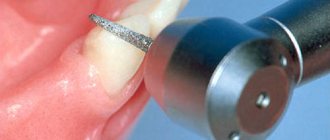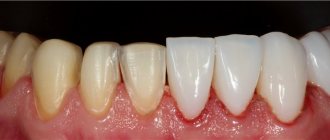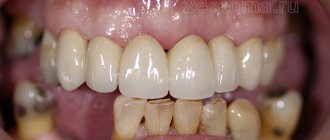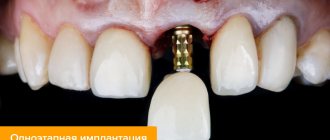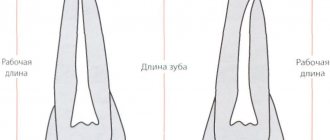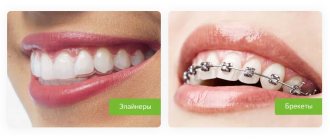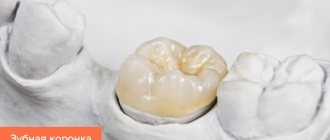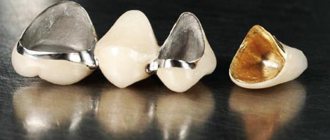Preparation of a tooth or grinding of a tooth for further installation of a metal-ceramic crown on it means cutting down special hard shells of the tooth, represented by mineralized tissues - dentin and enamel.
Preparation for metal-ceramic crowns
Description of the procedure
Tooth preparation is the removal of hard tissues that are damaged or interfere with the fixation of the crown.
Previously, turning under metal ceramics was long and painful. However, thanks to modern anesthesia drugs and the latest instruments, the duration and pain are significantly reduced.
During the procedure, the doctor strives to preserve healthy organs as much as possible. In this case, it is necessary to create natural forms, which is achieved through the formation of ledges.
For proper preparation, the following criteria must be met:
- the dental organ has retained its natural shape;
- the tooth stump is reduced and slightly tilted;
- the tooth is reduced in size by up to 2 mm;
- There are no unpleasant consequences near the dental organ.
Thanks to the preparation of teeth, the metal-ceramic crown receives the place it needs, so that it does not exceed the neighboring teeth in height and does not protrude outward or inward.
The crown should fit tightly under the gum, which is facilitated by a ledge under the gum.
To install a solid crown, up to 0.3 millimeters must be removed from the lateral surface without damaging adjacent teeth. To install a metal-ceramic prosthesis, the tooth is depulped and then 2 millimeters are removed from it. There should be a ledge on each side.
The doctor determines what size layer to remove based on the size of the tooth and the characteristics of its position in the dentition.
Does it hurt to put a crown and how to put a crown on a tooth in dentistry
From this article you will learn:
- does it hurt to put a crown,
- stages of prosthetics,
- how much does it cost to put crowns on teeth – prices 2022.
Making and installing a crown on a tooth is a complex procedure consisting of many stages. In this article we will talk about many subtle points that affect the aesthetics and service life of your crowns. These points relate to both mistakes when choosing the type of crowns by the patient himself, and mistakes made en masse by dentists at the stages of their manufacture.
For example, most of the complaints from patients about the quality of prosthetics relate mainly to 2 things. Firstly, poor aesthetics, and the fact that the crowns stand out against the background of neighboring teeth. Secondly, the quality of therapeutic preparation of teeth for crowns. The latter leads to complications - pain, suppuration, the need for re-treatment and even tooth extraction.
Does it hurt to insert teeth?
Typically, patients are interested not only in how a crown is placed on a tooth, but also how painful it is. The most unpleasant stages here, of course, are preparing teeth for prosthetics (i.e.
their treatment, root canal filling), and sometimes also the process of taking impressions. If already dead teeth are used for crowns, then turning them is completely painless and does not even require anesthesia.
If living teeth are ground down, a local anesthetic is first injected.
The only painful moment that I myself (being a dentist) have personally experienced is when, when taking an impression, the doctor performs gum retraction.
Retraction refers to the widening and deepening of the gingival sulcus, which is accompanied by a small degree of separation of the soft gum tissue from the tooth.
This is done in order to make a more accurate impression of the neck of the tooth, and it is better to do this immediately under anesthesia.
How is a crown installed on a tooth?
If you decide to put a crown on a tooth, then it will be useful for you to know what stages of this process you will have to deal with. In the process of placing a crown on a tooth in dental clinics, the following stages can be distinguished...
Initial consultation with an orthopedist (prosthetist) −
During the initial consultation, the doctor, assessing the condition of the teeth externally and using x-rays, must offer possible prosthetic options, and the patient, accordingly, must approve one of the options. Based on this, a treatment plan is drawn up, which may take into account -
- removal of non-viable teeth,
- preparing teeth for crowns (filling, depulping),
- choice of the type of crowns, for bridges - the number of supporting teeth, etc.
- The cost of making crowns and treatment in general is calculated, the deadline for prosthetics is determined, after which the patient must sign a treatment plan and a contract for the provision of services.
Important: at this stage the patient must choose one of the types of artificial crowns offered to him. Choosing the type of crown is not easy for the average patient, and there are a lot of pitfalls that the dentist will never tell you about. Articles to help you choose -
→ Pros and cons of metal-ceramic crowns → How to choose crowns for front teeth
Preparing teeth for prosthetics −
In some cases, crowns can be placed on living teeth. This is preferable because dead teeth are more fragile, and therefore, if the teeth are left alive, this has a positive effect on the service life of the crowns.
In what cases can teeth be left alive? As a rule, we are talking about large chewing teeth.
This is due to the fact that large teeth have a greater distance from the surface of the enamel to the pulp of the tooth (than single-rooted teeth) and, therefore, the risk of thermal burn of the pulp when grinding the tooth for a crown will be much lower.
Moreover, under crowns made of metal-free ceramics, even the majority of single-rooted teeth can be left alive. This is due to the fact that under ceramics the tooth is ground down by 1.0 from the side surfaces, and under metal-ceramics – on the same surfaces by 2.0 mm. Therefore, metal-free ceramics also allows you to increase the service life of the tooth itself under the crown.
When using metal-ceramic prosthetics for single-rooted teeth, the nerve is almost always removed. If this is not done, then turning such a tooth can lead to a thermal burn of the dental pulp, i.e. neurovascular bundle.
In this case, after some time, its inflammation will develop, and the crown will then have to be removed and the tooth re-treated.
If the tooth under the crown is destroyed by a carious process (there is pulpitis or periodontitis), then planned depulpation of the tooth and treatment of inflammation at the apex of the root are required.
When depulping a tooth, it is carried out -
- removal of a nerve from a tooth,
- instrumental treatment and expansion of root canals (Fig. 2),
- the canals are filled with gutta-percha (Fig. 3),
- after which a filling is placed on the crown part of the tooth (Fig. 4).
Important: if the crown part of the tooth is destroyed by 1/2 or more, the tooth must be strengthened with a pin fixed in the root canal (otherwise the crown can easily fall out along with the filling). There are 2 main methods for restoring severely damaged teeth.
What is the best way to restore a badly damaged tooth? –
- The first option (Fig. 5) – patients also call it a crown with a pin or a crown on a pin. This is when a pin is screwed into an already filled root canal, and then, based on it, the crown part of the tooth is restored using filling material. Only after such restoration is the tooth ground down for a crown.
- The second option (Fig. 6-8) – the crown part of the tooth is restored using a stump inlay. Such an inlay is cast from metal in a dental laboratory and consists of a root part (which is fixed in the canal) and a crown part, which has the shape of a tooth that has already been ground for a crown. This method provides greater reliability, strength and longer service life of the crown. Manufacturing of a core inlay for a crown -
Preparation of teeth for crowns −
In common parlance - grinding teeth. The preparation process is carried out by an orthopedic surgeon, who (using a drill and a set of diamond burs) gives the tooth a certain shape.
Preparation is a painful process if living teeth are ground down. In this case, local anesthesia is required.
When dead teeth are ground down, anesthesia is given only if the doctor needs to strongly press the gum away from the tooth during preparation.
The tooth tissue is ground down by the doctor to the thickness of the future crown (Fig. 9-11). Crowns made of metal-free ceramics (for example, zirconium dioxide or glass ceramics E.
max) require less grinding of tooth tissue - approximately from 1.0 to 1.5 mm on different tooth surfaces. But under metal-ceramics, the teeth are ground down on all sides by 1.5-2.5 mm - as a result of which almost nothing remains of the tooth.
As a result of preparation, the tooth crown takes on the appearance of a “stump”.
Tooth preparation for metal ceramics –
Important: high-quality tooth preparation for a crown is a very complex and time-consuming process. The most difficult thing here is to create a ledge in the gingival part of the tooth crown.
The reliability and service life of your crown largely depends on the correct formation of the ledge. It must be admitted that most doctors make a lot of mistakes at this stage.
How the ledge is formed is clearly shown in the video below.
Grinding front teeth for crowns: video
Taking impressions, making plaster models of teeth –
Impressions are taken from the ground teeth using special impression compounds (Fig. 12). Subsequently, based on these casts, plaster copies of your teeth are created in a dental laboratory (Fig. 13). Such plaster models depict the patient’s teeth with very high accuracy, including those ground for crowns, and it is from such models that they are manufactured.
Peculiarities
Grinding teeth for metal ceramics has the following features:
- The need to remove a significant layer of enamel and dentin (up to 2 millimeters).
- The use of anesthesia so that the patient does not feel pain during grinding. The most common methods are infiltration and conduction anesthesia.
- The main goal of specialists is to preserve as much bone tissue as possible and remove all damaged areas.
- After removing the tissue, a truncated cone is obtained, the edges of which are then slightly rounded.
- Grinding should be done intermittently after every 2-3 seconds.
- The tool must be constantly cooled during grinding so as not to cause a burn to the pulp.
- The contact surfaces must be ground with the device at low speeds.
Types of ledges during turning
For reliable fixation of the crown, it is necessary to carry out turning with a shoulder.
The most common types of teeth grinding are:
Photo: Grinding teeth with a ledge
- A knife-shaped ledge, the width of which is 3–4 mm, is a commonly used type. It is used for all-metal crowns and is optimally suited for turning inclined teeth.
- The grooved rounded ledge allows you to preserve dental tissue in the maximum amount. Its width is 0.8 - 1.2 mm. This is a classic option for metal ceramics.
- The shoulder ledge is the most uneconomical type of turning, requiring depulpation. The width of the ledge is 2 mm. However, such a ledge allows the crowns to be fixed more firmly and has higher aesthetic values.
Stages of the procedure
Let's take a step-by-step look at how teeth are ground for a metal-ceramic crown:
- Creating grooves. The doctor makes peculiar incisions that will show how much hard tissue needs to be removed. These grooves subsequently contribute to uniform grinding. Creation of notches can be done with a bur or a shaped head in the form of a wheel. They are carried out from the vestibular side to a depth of 1.5 millimeters. The ledges on the palatal and vestibular sides are removed.
- Removing tissue from the vestibular and oral sides. Maximum caution is important at this stage. Diamond burs directed parallel to the tooth remove the required layer. When working on the palatal side, the palatal tubercle is preserved.
- Preparation from the occlusal surface. This stage consists of preparing one and a half to two millimeters, while not disturbing the anatomy of the chewing surface. The living crown of the anterior dental units is thus shortened by 25%.
- Separation of the contact side. It is important to separate the medial surface from the distal one and then remove the tissue. A diamond bur with flame-shaped or needle heads is used. 0.5 millimeters are left above the gum. To prevent periodontal injury, a dental matrix and an interdental wedge are used.
- Gum retraction. If it is necessary to immerse the bur deeply, you need to protect the gums. Therefore, it is moved away with the help of special threads, rubber rings and a spatula. This stage is important for taking an impression so that a high-quality model can be easily made.
- Formation of the ledge. The width of the ledge can be 0.5-1.5 millimeters, depending on the anatomy of the dental organ. It is made with a face bur.
- The final stage of processing. The dental stump should be in the form of a uniform cone. At this stage, irregularities are cut off, protruding edges are removed, and the stump is rounded.
Does it hurt to put crowns on your teeth?
Almost all patients faced with the need to install a crown are interested in the question of whether the process of prosthetics involves pain and other discomfort. Unfortunately, almost all dental procedures are quite painful, so most of them are performed under local anesthesia.
Whether it hurts to put a crown on a tooth depends on the professionalism of the dentist himself and the characteristics of the body (sensitivity threshold) of the patient himself. As a rule, unpleasant sensations can arise exclusively during the preparatory stage of prosthetics, which includes:
- removal of the dental nerve;
- depulpation, cleaning of canals;
- grinding of hard tissues (the “working” tooth is ground down using a bur machine so that the crown “fits” well).
Nevertheless, the use of good anesthesia and precise, calibrated work by the dentist can reduce the risk of discomfort at the preparatory stage of prosthetics to nothing.
Therefore, those patients who are interested in whether it is painful to grind teeth for crowns can safely go to the dental office without fear of discomfort.
As for the process of installing a prosthesis on a dead tooth, it is absolutely painless - the product is adjusted and fixed with a special glue.
Advances in modern dentistry allow the use of local anesthetics, which eliminate the risk of discomfort during work.
The “working” unit is depulped (the nerve is removed), which means that pain sensations as such are completely eliminated.
Even the gums into which an anesthetic injection is given before starting work will not hurt - the dentist first applies an anesthetic gel to it. So, prosthetics, i.e.
Installation of metal-ceramic and ceramic crowns on the front or chewing teeth is a painless procedure.
The most potentially dangerous, from the point of view of the possibility of pain, is the preparatory stage - removing the nerve, cleaning the canals, depulping, turning the tooth. But the professional work of the dentist in combination with local anesthesia makes it possible to make it as comfortable as possible for the patient.
Reviews
Irina, 46 years old, Moscow: A year ago I had metal ceramics installed on 2 chewing teeth. The procedure, to be honest, is not pleasant - the doctor was unable to “seat” the crowns onto the stumps for a long time, as a result of which the gums became inflamed (even now they swell and hurt from time to time).
In order to “finish” both prostheses, I had to spend a lot of time and money (I went to the dentist 5-6 times while the preparation, fitting, and fixation of the crowns was going on). However, now I have no discomfort, I can bite, chew, and smile.
The dentures have not changed the original color and structure.
Konstantin, 35 years old, dentist, Novosibirsk: Putting any crowns correctly is an art. This is a job that requires professionalism, precision, care and precision. Modern anesthetics make prosthetics painless, so patients who have indications for crowns need not worry about experiencing discomfort.
Elena, 60 years old, St. Petersburg: Before going to the dentist, I thought for a long time, read reviews on the Internet, chose a clinic and the type of dentures.
As it turned out, I was worried in vain - despite the fact that 6 metal-ceramic crowns cost me a lot, the preparation, fitting, and installation itself were painless - there were no unpleasant sensations or complications.
Laser processing
Thanks to laser pulses, a thermal effect occurs on the fluids contained in the teeth. In this case, the structure of the material is microscopically destroyed. Unnecessary tissue is then cooled with an aqueous solution or air, and then removed without hindrance.
Laser preparation has the following advantages:
- no noise when the tool operates;
- safety of the procedure due to the absence of tips in the device that rotate at high speed;
- the frame for the future crown is obtained quickly and without pain;
- infection during the procedure is excluded, since the instrument does not touch the tissues.
Possible negative consequences
If the doctor prepares the tooth incorrectly, the patient may experience severe discomfort or other complications.
- If the preparation procedure is carried out carelessly, the integrity of the tooth may be compromised. This in turn leads to irritation of the pulp and the formation of edema. This complication goes away without a trace over time.
If the doctor prepares the tooth incorrectly, swelling of the gums may occur.
- After the anesthesia wears off, pain in the tooth or gum may occur. What are the reasons for this phenomenon? First of all, this means that the preparation was carried out on a living tooth. Increased sensitivity may occur due to thinning of the tooth walls after grinding. The tooth begins to react sharply to various external factors. They can be taste, temperature factors, physical effects. To correct this phenomenon, an additional portion of cementing material is applied to the surface of the sensitive part of the tooth.
- When manipulations are carried out deep in the gum, for example, when forming a ledge, it is necessary to expand the visible working area. For these purposes, a special thread is used. With its help, the edges of the gums are moved back. Sometimes this effect on soft tissue can cause pain and swelling of the gums. Usually these symptoms do not last long and disappear on their own after some time.
Gum retraction
- If more time has passed and these symptoms have not gone away, it may be a more serious complication and treatment is necessary.
Tunnel preparation
Tunnel turning is carried out using turbine units with diamond or metal tips. At the same time, it is important that the equipment is new, since a worn-out instrument can cause overheating of the tissues and their destruction.
Note: With this method, it is possible to save as much material as possible for future crown installation. The result of removal can be predicted in advance, and during the procedure it is easy to control the volume of the removed layer.
This type of preparation is used today more often than other methods.
Cost of services
If treatment is started on the day of treatment, consultation and treatment plan are free
| Teeth cast (impression) polyvinylsiloxane (1 piece) | RUR 2,000 |
| Temporary crown (laboratory manufacturing method) | RUR 2,500 |
| Solid crown | RUB 7,900 |
| Metal-ceramic crown with ledge | RUB 13,700 |
| Metal-ceramic crown | RUB 11,500 |
| MK crown using shoulder masses | RUB 15,500 |
| Metal-ceramic crown supported by an implant | 28,000 rub. |
| Individual abutment for the implant (cost depends on the material) | from 15,000 rub. |
| Ceramic crown E.max Press (with application) | 22,000 rub. |
| Ceramic veneer using E.max Press technology | 20,000 rub. |
| Ceramic crown on a zirconium dioxide frame | from 32,000 rub. |
| Zirconium dioxide veneer | RUB 21,000 |
| Core inlay CoCr | RUB 7,500 |
| Unsealing 1 channel under the tab | 1,300 rub. |
| Partial removable denture | 22,000 rub. |
| Complete removable plate denture (1 person) | 25,000 rub. |
| Plate prosthesis reinforced with mesh | RUB 32,500 |
| Removable clasp nylon prosthesis “Quadrotti” (1 person) | 55,000 rub. |
| Complete removable nylon denture | 45,000 rub. |
| Removable denture, microprosthesis (up to 3 teeth) (cost depends on the chosen material for the denture) | from 8,000 rub. |
| Partial removable plate denture made of ImplFcryl plastic (including silicone and imported teeth) (1 person) | 45,000 rub. |
| Complete removable plate denture made of ImplFcryl plastic (including silicone and imported teeth) 1 person. | 55,000 rub. |
| Complete removable denture Acri-free | 60,000 rub. |
| Removable partial denture Acri-free | RUB 55,000 |
| Clasp prosthesis (2-3 clasps) | 35,000 rub. |
| Clasp prosthesis complex splinting | 60,000 rub. |
| Clasp prosthesis with locking fastenings “Bredent” | 65,000 rub. |
Preparation with abrasives
An alternative to a drill with its rotating drills is also the supply under pressure of air mixtures containing an abrasive powdery substance. By acting on the enamel, this mixture gradually removes hard tooth tissue.
Features of preparation with abrasives are as follows:
- speed of the procedure;
- absence of tissue overheating and painful sensations;
- gentle effect on the dental shell;
- careful grinding, which allows you to obtain the necessary stump while preserving a significant amount of healthy tissue.
Techniques
There are a number of methods for grinding teeth.
Ultrasound
Advantages of ultrasonic turning:
- Minimum pressure on the tissue of the working tips.
- There is no overheating of enamel and dentin.
- Painless procedure.
- No chips or microcracks on the walls of the pin.
- There is no negative effect on tooth tissue.
Laser
Photo: Laser turning of a tooth
Pulsed lasers are used for preparation.
Their effect is that the water in the tooth tissues is strongly heated under the influence of the laser. This leads to disruption of the integrity of enamel and dentin.
With the help of a water-air mixture, their microscopic particles are destroyed and removed.
Advantages of laser turning:
- Silent operation of the equipment.
- Low heating of tooth tissues.
- The procedure is highly secure, since there are no rotating elements.
- High preparation speed.
- No chips or cracks on the pin.
- Absence of factors contributing to infection.
Tunnel preparation
Turbine units are used for grinding teeth, allowing you to regulate the speed of work, as well as metal or diamond tips.
The quality of such equipment has a direct impact on the result of turning, since instruments used for a long time cause overheating of the tooth tissue, which increases the risk of tooth destruction.
When tunnel grinding, it is necessary to leave as much tooth tissue as possible.
The advantage of the technique is a clear prediction of the result and the ability to control the thickness of the tissue layer being removed.
Disadvantages of the technique:
- The possibility of tissue overheating and severe pain with insufficient pain relief.
- Injury to soft tissues due to violation of the procedure technique.
- There is a high risk of cracks and microchips of hard tissue when using low-quality instruments.
Air abrasive method
An air mixture with abrasive powder is used, supplied under high pressure. When it gets on the tooth enamel, minor destruction and removal of tooth dust occurs.
Advantages:
- High speed and simplicity of the procedure.
- No pain or heating of tooth tissue.
- When preparing living teeth, the absence of vibration has a positive effect on the condition of the pulp.
- Maintaining maximum tooth volume.
Chemical turning method
It involves the use of a chemical substance that promotes the destruction of enamel and dentin.
The disadvantage is the duration of the procedure. Sometimes the duration of exposure reaches thirty minutes.
Advantages:
- No need for pain relief.
- There is no thermal damage to the tooth.
- There are no small cracks or chips on the enamel.
- The presence of psychological comfort due to the absence of sound from the drill.
Is dissection painful?
Removing hard tissue is a painful procedure. But with high-quality anesthesia, the patient does not feel pain at all. However, there are situations when, after the anesthesia wears off, the tooth or gums around it begin to hurt.
The main cause of pain in this case is the removal of a large amount of tissue from the vital dental organ. In this case, the tooth, the pulp of which is located under the remaining thin layer of hard tissue, hurts when touched, as well as when exposed to cold or sour food. In such a situation, it is better to consult a doctor so that he can install a temporary crown to protect the ground tooth or cement the thinned area.
Pain may also be a consequence of pushing back the gums with a special thread in order to see the working area when grinding. The floss puts pressure on the soft tissue between the tooth and gum, creating swelling and pain. This pain should go away within two days. If it occurs after a longer period of time, it is better to consult a doctor, as this may be a signal of nerve inflammation or the development of periodontitis.
Preparation for inlays: principles and rules
Inlays are partial dentures and are used to replace large defects in dental tissue.
Depending on the form, there are the following types of tabs:
- Inlay (inlay) - minimally invasive, since they do not affect the tubercles of the tooth;
- Onlay (onley) - serve to replace the internal slopes of the dental tubercles;
- Overlay - cover the entire volume of at least one tubercle;
- Pinlay (pinlay) - cover all dental cusps and have a special pin in their design - pin;
- stump inlays are a metal pin used in cases of severe destruction of tooth tissue and serving as a support for the crown.
Depending on the materials used, the inlays can be ceramic, metal or reinforced composite.
The main feature of preparing teeth for inlays is the need to create parallel side walls near the cavity for proper insertion of the finished structure, as well as to create sufficient depth for reliable fixation of the element.
Basic principles of turning for inlays:
- The prepared cavity must have an optimal shape for the smooth insertion and removal of the prosthesis. In this case, it is necessary to strive for maximum parallelism of the vertical walls. We allow only a slight angle of their deviation.
- The angle of transition of the cavity walls to the bottom should approach a straight line. The relationship of all walls should contribute to the uniform distribution of chewing pressure and maximum stability of the inlay.
- When forming the day, it is necessary to take into account that a minimum layer of tissue should remain above the pulp to ensure its protection from external factors. In adults, this value is 0.6 mm, and in children and adolescents - 1.4 mm.
- When forming complex cavities, additional fixation points should be formed to allow the inlay to be firmly fixed.
- When forming a cavity for metal inlays, it is necessary to create a bevel at the level of the enamel with a width of at least 0.5 mm and at an angle of 45°, which will ensure more accurate marginal contact of the prosthesis and tooth tissue.
- In the manufacture of metal-free structures, the presence of a bevel is contraindicated due to the fragility of materials with a small thickness.
Purpose of installing temporary crowns
After grinding down the tooth, a temporary crown made of plastic is placed on it, which will remain in the oral cavity for two or three weeks while the permanent prosthesis is made.
For some patients, the fact that a doctor makes and places a temporary crown is incomprehensible and even seems meaningless.
But this procedure is simply necessary. Since temporary crowns protect teeth from external influences, and also correctly distribute the load when chewing.
The advantages of using temporary crowns are as follows:
- Teeth ground for a crown are not protected from the harmful effects of pathogenic bacteria, which can cause inflammation of the teeth under a permanent crown, and temporary products protect them from infection.
- When biting, a ground tooth can be displaced by the opposite dental organ, which can lead to unwanted errors during prosthetics.
- Temporary dentures give the oral cavity an aesthetic appearance, and with it the patient’s self-confidence. They operate in the same way as permanent ones, only they are made from budget material.
Is turning necessary?
Unfortunately, despite the latest technologies and advances in dentistry, it is not possible to skip the stage of tooth preparation.
- In order for the crown to be firmly fixed on the tooth, it must fit to it with maximum precision. The natural shape of teeth is not ideal; their side walls have a convex shape, which excludes the possibility of creating a crown of this shape.
- As a result of grinding down the enamel, the surface of the tooth becomes the correct shape, onto which a crown can be easily fixed.
- In addition, the design itself has a certain thickness, which must be taken into account so that you do not feel discomfort in the oral cavity when eating and talking.
Cost of a metal-ceramic tooth, reviews
The cost of a metal-ceramic tooth is influenced by the pricing policy of the clinic and the manufacturer of the ceramic coating. Surely, having decided to replace lost teeth, metal ceramics, reviews, photos and attractive prices prove their advantages, and also allow you to replace your natural teeth. Metal-ceramics, the cost of which is determined mainly by the type of ceramic powder, will last a long time with proper prosthetics.
Therefore, when paying attention to the cost of a metal-ceramic tooth, you should also take care to study reviews and get advice from a doctor who provides dental prosthetics. Metal-ceramics, reviews from specialists and patients as a whole with photo support can give the right direction and finally replace the missing tooth. Metal ceramics and the cost of prosthetics services are related to the qualifications of the prosthetist and the reputation of the clinic. We always take into account individual characteristics and explain in detail whether it is worth installing metal ceramics in a particular case and what the cost of our services is.
Are there any complications?
In most cases, complications are temporary and completely reversible:
- Damage to the gums due to improper processing. Collapse of the gum line may occur, leading to pain, inflammation, and gradual atrophy of the soft tissue. The problem requires surgical treatment. When an infection occurs, gingivitis can develop.
- Tooth opening during grinding. The doctor will accumulate (restore) the destroyed fragment or remove the pulp and install a pin.
- Inflammation of the pulp after the procedure. It is characterized by swelling and discomfort and is temporary.
How much does a tooth cost? Metal ceramics, price
Of course, what is important for us when setting prices is how much a metal-ceramic tooth costs, and what price we can offer the patient so that this does not become a stumbling block before placing a tooth. Metal ceramics, the price of which is significantly lower than the cost of other materials, receives grateful reviews because it combines a number of advantages.
Sometimes the necessary grinding is confusing, but any prosthetics involves preliminary processing in order to install artificial teeth. Metal-ceramics - the prices it offers in addition to photos and reviews confirming the high quality - it is not for nothing that it so proudly retains the title of leader in prosthetics. Until recently, when asked how much a tooth costs, metal-ceramics was practically the only answer with an affordable price.
Agree that walking without teeth when there are so many charming photos with beautiful teeth around is not an easy task. What if, after reading the reviews, you get the impression that the cost of the clinic’s services will be too high and is it worth installing artificial teeth at all? Metal-ceramics, the price of the material and the cost of the service are attractive due to their availability. Studying different options for how much a tooth costs, metal-ceramics will always offer the optimal price-quality ratio.
Advantages of live tooth preparation
It is much easier for a doctor to dissect a living tooth than one in which the nerve is already dead.
- Depulped teeth are much weaker than living ones, which do not break or crumble over time.
- Living teeth are much more resistant to caries.
- No need to install pins.
- The procedure for depulping teeth is not cheap. Prosthetics of living teeth significantly reduces the financial costs of the patient.
- The dental nerve is preserved.
It is much better to prepare a living tooth than one with a dead nerve.
How is preparation done on a living tooth?
- Grinding of a living tooth must be carried out under anesthesia in a slow mode.
- A new bur and a special handpiece are used for each patient.
- To prevent the occurrence of an inflammatory process, a special coating is applied.
- After the grinding procedure, temporary crowns are immediately installed on the prepared teeth, which are fixed with special cement containing an antiseptic.
Temporary crowns are placed on the teeth after preparation.

